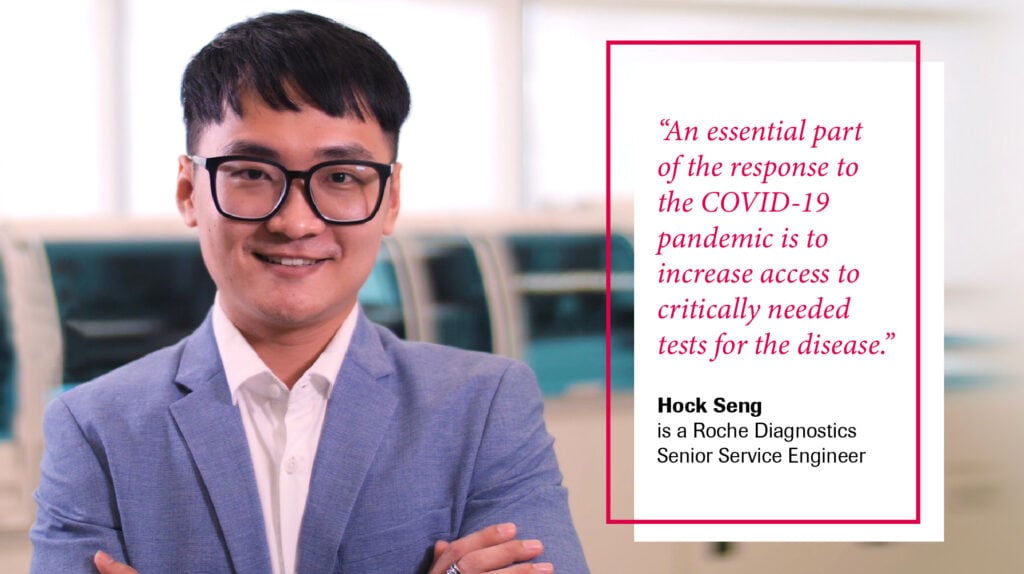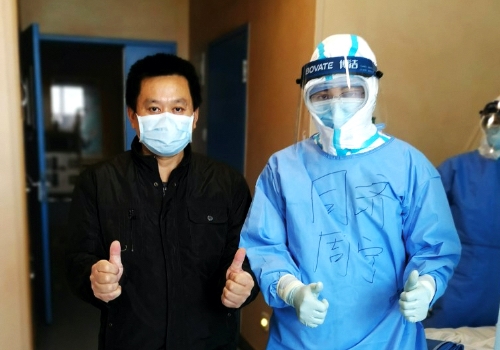At the front line of the fight against COVID-19 are not just doctors and healthcare professionals, but also mission-critical workers who provide services and expertise. 29-year-old Service Engineer Hock Seng shares his story with Roche Diagram magazine, explaining how he supports medical decision-making, troubleshooting one day at a time.

I have been working at Roche Diagnostics APAC for nearly five years and since the very beginning, it’s been a demanding and fast-paced environment. Solving problems is exactly what I do here, every single day. As Service Engineers, we install high-tech laboratory equipment and conduct technical repairs and planned maintenance for our range of analysers and diagnostic systems. People assume that our job is very easy, that it’s about replacing parts of a machine. But it’s more complicated than that. We support customers on a 24/7 basis and respond to ad-hoc queries by troubleshooting sophisticated systems which healthcare professionals rely on to diagnose and manage patient medical conditions.
Each day in labs across the APAC region, critical patient results are being generated around the clock. Our service and support teams are 2500 in number and we partner with laboratorians to help deliver testing accurately and efficiently. More than 60 percent1 of clinical decisions are based on diagnostics, which deliver information that enable health professionals to choose appropriate treatment and care interventions.2 If our instruments are not well maintained, they may cause delays or even result in wrong treatment. For example, in patients with heart conditions, every 30 minutes of delay between the symptoms and treatment increases one-year mortality risk by 7.5 percent3. We cannot afford to make a single mistake, because it can directly impact a patient’s health condition and diagnosis.
In a given week, we usually attend five to seven jobs, but during COVID-19, our work has doubled. Soaring demands for quality-assured, accurate tests have meant that our diagnostic instruments are being pushed beyond the limit. An essential part of the response to the COVID-19 pandemic is to increase access to critically needed tests for the disease. Since our machines are in continuous use, we are regularly out in the field to analyse instrument problems, repair and perform instrument refurbishing.
Going digital has definitely aided our work during this period. We have to maintain social distancing and at times are not allowed to enter lab areas where highly infectious samples are being tested. Relying on digital applications has meant that we can troubleshoot our customers’ challenges even virtually. Just like healthcare professionals use diagnostic technology to gain insight into our individual physiology, we also study the anatomy of a machine and how its various parts interact with one another. Clocking nearly 1,400 hours of virtual training so far this year has made our team more experienced and able to provide better support to customers at all times. By understanding an instrument’s operational and hardware components, we know which part is abnormal or defective and can troubleshoot accordingly.
Related read: Understanding COVID-19 Testing
People say life is beautiful when you find purpose. For me, nothing is more meaningful than adding value in the healthcare space. As a young child, seeing my mom battle breast cancer for nearly two decades made me feel very helpless. Though I studied rigorously to become a doctor, I didn’t make the cut. But I never gave up on the idea of helping save lives, in my own way. Now, when my little nieces and nephews wonder what I do, I tell them I’m the Machine Whisperer. I nurse and heal ailing machines and help them recover rapidly — so that doctors are able to care for patients quickly and effectively.
Read more inspirational medical stories at Roche Diagram.
References:
1 Beastall, GH . Adding value to clinical biochemistry. Ann Clin Biochem 2010;47(Suppl 1):1
2 Porter ME. What is value in health care? N Engl J Med. 2010 Dec;363(26):2477–81.
3 De Luca G, Suryapranata H, Ottervanger JP, Antman EM. Time delay to treatment and mortality in primary angioplasty for acute myocardial infarction: every minute of delay counts. Circulation. 2004;109(10):1223–5. [PubMed] [Google Scholar]














